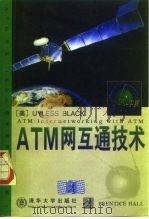《现代通信最新技术 第2版英文版》
| 作者 | (美)(U.布莱克)(Uyless Black)著 编者 |
|---|---|
| 出版 | 北京:清华大学出版社 |
| 参考页数 | 457 |
| 出版时间 | 1998(求助前请核对) 目录预览 |
| ISBN号 | 730202815X — 求助条款 |
| PDF编号 | 87515208(仅供预览,未存储实际文件) |
| 求助格式 | 扫描PDF(若分多册发行,每次仅能受理1册) |

ContentsPrefaceⅹⅸCHAPTER 1 Introduction1
Introduction1
The Need for Enhanced Services1
The Past 1
The Future Has Become the Present 3
Goals of the EmergingCommunications Technologies 4
LAN Interconnectivity5
A Brief Summary 5
Neec for Greater Communications Capacity5
Alternatives to the Overhead of IPv6
LAN and WAN Internetworking9
Costs of Connecting Dispersed LANs11
The Virtual Private Network(VPN)11
Proposed Solutions14
The Confusion Factor16
Fast Relay Systems 17
Trends in Technology 19
Hardware and Software 19
New Technologies:To Use Them or Notto Use Them?22
Broadband Networks 24
Broadband Signaling Hierarchies24
New Technologies:Competitive or Complementary?27
Applications Supported by the New Technologies27
Performance and Distance Considerations29
Obtaining Services for the Networks:Bandwidth on Demand 31
Where Services are Provided 32
Layered Architectures of the Emerging Technologies34
Summary35
CHAPTER 2Foundations for the Emerging Technologies36
Introduction36
Virtual Circuits 37
A Brief Digression38
Pemmanent Virtual Circuit(PVC)39
Semi-permanent Virtual Circuits(SPVC) 40
Switched Virtual Circuit(SVC)or Connectionon Demand 40
Connection-oriented and Connectionless Systems41
Connection-orientated Systems 41
Connectionless Systems 41
The Pros and Cons 41
The Coexistence of Connection-oriented Systemsand Connectionless Systems 42
CBR Applications 43
VBR Applications 43
Variable Bit Rate(VBR)and Constant Bit Rate(CBR)Applications 43
Flow Control and Congestion Management 45
Explicit Flow Control 45
Implicit Flow Control 45
No Flow Control 45
User Payload Integrity Management 46
Layered Protocols and Protocol Data Units 47
Addressing and Identification Schemes 49
Multiplexing Methodologies50
Switching,Routing,and Relaying 50
Fixed and Adaptive Routing51
Source and Non-source Routing51
Network Interfaces 51
Convergence,Segmentation,and Reassembly Operations 53
Summary54
CHAPTER 3Emerged Technologies55
Introduction55
T1/E1 CARRIER Systems 56
The Purpose of T1 and E1 56
Typical Topology 57
T1 and E1 Layers 58
T1/E1 PDUs59
Conclusions on T1/E1 60
X.2561
The Purpose of X.25 61
Typical Topology 61
X.25 Layers62
X.25 PDUs 63
Other Noteworthy Aspects of X.2564
Conclusions on X.2565
The Purpose of ISDN 66
ISDN66
Typical Topology 67
lSDN Layers70
ISDN PDUs 71
Conclusions on ISDN 74
Signaling System Number 7(SS7) 75
The Purpose of SS775
Typical Topology 75
SS7 Layers 77
SS7 PDUs 80
Conclusions on SS7 81
FDDI 81
The Purpose of FDDI 81
Typical Topology 82
The FDDI Layers83
FDDI PDUs 84
Other Notable Aspects of FDDI 85
Summary 86
Conclusion on FDDI 86
CHAPTER 4Frame Relay 87
Introduction87
The Purpose of Frame Relay 87
Pertinent Standards 88
Typical Frame Relay Topology 89
The Frame Relay Layers 91
Frame Relay and Its Relationshipto ISDN Layers 92
OSI and ANSI Layers 94
The Frame Relay Core Functions95
The Frame Relay Protocol Data Unit(PDU)95
Frame Relay Operations in More Detail95
The Data Link Connection Identifier(DLCI)96
Frame Relay Link Layer Error Checking98
Potential Congestion Problems 99
Traffic Management100
Consolidated Link Layer Management(CLLM)103
The Discard Eligibility Bit104
Committed Information Rate105
Leaking CIR and Fast Forward CIR110
Classes of Service Using Bcand Be 111
DLCIs in More Detail 112
The Frame Relay Network-to-NetworkInterface (NNI)114
NNI Operations114
Bellcore Exchange Access FR(XA-FR)PVC Service116
DLCI Values120
Added Options to Frame Relay120
Other Notable Aspects of Frame Relay120
The Local Management Interface(LMI)122
Frame Relay SVC Operations122
Other Quality of Service(QOS)Options123
Internetworking Frame Relay and ATM124
Multiprotocol Operations over Frame Relay125
The Frame Relay MIB128
Frame Relay Worksheet129
Summary 131
Introduction132
Generations of LANs132
CHAPTER 5Fast and Switched Ethernet132
First Generation 133
Second Generation 134
Third Generation134
Fourth Generation135
Switched Ethernet135
Switched Ethernet Architecture135
Store and Forward and Cut-through Switches137
Virtual LANs139
Fast Ethemet 139
100BASET141
AnyLAN 141
Fast/Switched Ethernet Worksheet142
Summary143
Introduction144
The Purpose of a MAN144
CHAPTER 6Metropolitan Area Networks(MANs)and SwitchedMultimegabit Data Service(SMDS)144
Pertinent Standards145
A Typical MAN Topology 145
Topology Reconfiguration with Self-HealingNetworks147
The MAN Layers148
MAN Protocol Data Units(PDUs)148
MAN Operations in More Detail149
The Access Unit(AU)149
Overview of the DQDB Protocol151
DQDB Counters152
Location Discovery 154
Segmentation and Encapsulation Operations155
Other Notable Aspects of the MAN164
The Purpose of SMDS166
Introduction to SMDS166
MANSummary 166
Pertinent Standards167
A Typical SMDS Topology168
SMDS Layers170
SMDS Protocol Data Units171
SMDS Operations in More Detail171
Defining and Measuring Congestion171
The Sustained Information Rate(SIR)and Access Classes174
SIP Segmentation and Encapsu lation Functions177
SNI Quality of Service(QOS)Operations178
The Interchange Carrier Interface(ICI)179
Quality of Service(QOS)Objectives180
SMDS Address Management Operations180
Other Notable Aspects of SMDS180
The ISSI181
The Operations System/Network Element(OS/NE)Interface (Operations Technology)182
The SMDS MIB 184
MAN/SMDS Worksheet186
SMDS Summary187
CHAPTER 7Asynchronous Transfer Mode(ATM)188
Introduction188
The Purpose of ATM188
Pertinent Standards189
An ATM Topology189
The VPI and VCI Labels192
ATM Layers193
ATM and the B-ISDN Model196
ATM Protocol Data Units(Cells)198
ATM Operations in More Detail199
Physical Layer Interfaces199
ATM over Copper 201
Rationale for the Cell Size202
Network Transparency Operations202
ATM Labels209
Multiplexing VCIs and VPIs 210
ATM Connections on Demand211
ATM Switching215
Classes of Traffic 224
AAL Types227
Traffic Management in an ATM Network232
ATM Forum and ITU-T Traffic Controland Congestion Control 238
The ATM B-ISDN Intercarrier Interface(B-ICI)240
Physical Layer Requirements at the B-ICI243
Traffic Management at the B-ICI243
Reference Traffic Loads 244
B-ICI Layer Management Operations245
Other Notable Aspects of ATM245
Addressing in an ATM Network245
Network Management247
The ATM MIB 247
ATM Worksheet249
Summary 250
CHAPTER 8Synchronous Optical Network(SONET)/Synchronous Digital Hierarchy(SDH)251
Introduction 251
Purpose of SONET/SDH251
Synchronous Networks 253
Typical SONET/SDH Topology 255
Pertinent Standards 255
SONET/SDH Layers260
SONET/SDH in More Detail262
Automatic Protection Switching(APS)262
The SDH Multiplexing Structure 263
Payloads and Envelopes 264
Payload Pointers 269
Examples of Payload Mapping 270
Mapping and Multiplexing Operations275
Error Checking,Diagnostics,and Restoration277
The Control Headers and Fields279
SONET/SDH Equipment285
Other Notable Aspects of SONET/SDH293
Operation Administration and Maintenance(OAM)Operations293
Progress in SONET/SDH Penetration295
SONET/SDH Worksheet295
Summary296
CHAPTER 9Mobile Communications Technologies297
Introduction 297
The Purpose of Mobile Communications Systems 297
Typical Cellular Systems Topology 298
Cellular System Types and Market Penetration 300
Cellular Systems Operations in More Detail 300
GSM 302
GSM Interfaces 304
Call Routing307
Location Updating 308
(TDMA)309
CDMA:A New Arrival into the CommercialMobile,Wireless World310
TDMA versus CDMA311
Cordless Systems Operations in More Detail 312
CT2312
DECT313
Other Standardization Efforts for PCS314
The Auctions in the U.S.and the PCS Marketplace 315
Candidates for PCS Technologies 316
The Cellular Digital Data Packet SystemSpecification(CDPD) 317
CDPD Services and Servers319
Third-Generation Mobile Systems 321
Some Concluding Thoughts 321
Mobile Communications Systems Worksheet322
Mobile Communications Summary323
Introduction 325
CHAPTER 10Residential Broadband325
The Problem with the Subscriber Loop 326
The Proposed Solutions:Two Interlocking Approaches,Coding/Modulation and Wiring 326
How Much Bandwidth Is Needed to Satisfythe Subscriber?327
Downstream Bandwidth 328
Upstream Bandwidth328
Beyond the Coding/Modulation and Wiring:Service Provisions 329
Switched Digital Video(SDV) 330
Coding and Modulation330
HDSL 330
ADSL 331
Hybrid/fiber Copper(HFCop) 332
Wiring at the Local Loop:Subscnber Loop Options332
Hybrid/fiber Coax(HFC)334
Fiber to the Curb(FTTC)and Fiber to theHome(FTTH) 337
The Wireless Option 337
Mananging the Broadband Signals 339
Bellcore s TR-303 Specification 340
Residential Broadband Worksheet 340
Summary 340
Introduction 342
Quadrature Amplitude Modulation(QAM) 342
Appendix 10A:Coding and Modulation Techniquesfor Residential Broadband 342
Examples of Modulation Schemes and Bit Rates347
Carrierless Amplitude/Phase Modulation(CAP)347
CHAPTER 11Broadband Signaling Networks349
Introduction 349
What Are Broadband Signaling Networks?349
Differences between Broadband and ConventionalSignaling Systems 350
N-ISDN and B-ISDN351
Example of a Broadband Signaling Network Operation 351
Examples of Services Providedby the Broadband Network 354
ISO 9577 355
The Broadband Signaling Protocols 356
ATM Parameters 356
How the Broadband Signaling Stacks Operate 357
Broadband Signaling Worksheet360
Summary 360
CHAPTER 12Advanced Intelligent Network361
Introduction361
Operator Services Systems(OSS) 361
The 800 Service Inklings of an Advanced IntelligentNetwork(AIN)362
Key Aspects of the AIN364
The Intelligent Network and the Advanced IntelligentNetwork364
Distribution of Functions365
Evolution to the AIN366
Other Parts of the AIN367
Example of an AIN Operation369
The AIN Basic Call Model 370
Standardized Messages 374
The Private Virtual Network375
AIN Worksheet377
Summary 378
CHAPTER 13Internet Protocol,Version 6(IPv6)379
Introduction 379
Functions of the Internet Protocol(IPv4)379
The IP Address 381
The Solution——an Expanded IP AddressSpace 383
Problems with IP and the IP Address383
Addresses 384
The Next Generation IP——IPv6 384
Functions of the IPv4 Header Fields384
Functions of the IPv6 Header Fields387
IPv6 andATM 388
Fixed Routing and Virtual Circuits388
Supporting Different Types of Traffic 389
The IPv6-ATM Debate389
IPv6 Worksheet 390
Summary 390
APPENDIX A A Tutorial on Communications Networks393
Introduction 393
Data Communications Networks 393
Classifying Networks 393
Wide Area and Local Area Networks 394
Network Components 395
Voice Networks 398
Nonhierarchical Routing 400
History of and Inherent Problems with Coexistenceof Analog and Digital Systems 400
Analog-to-Digital Conversion 401
Data Images over Voice Channels 404
FDM,TDM,and STDM 405
Circuit,Message,Packet,and Cell Switching 409
Network Routing Operations 411
The Challenge of Integrating Voice,Data,and Video Applications 414
Fast Packet Switching(FPS) 416
Hybrid Switching 417
Introduction 419
Protocols and the OSI Model 419
APPENDIX B Layered Protocols,OSI,and TCP/IP 419
OSI Layer Operations 420
The Internet Protocols(TCP/IP) 426
The Internet Layers 428
IP Functions 430
TCP Operations 432
Introduction 435
Purpose of a MIB 435
APPENDIX C Management Information Bases(MIBs) 435
Examples of MIB Objects and Other Entries 436
APPENDIX D Emerging CommunicationsTechnologies Worksheet 438
Abbreviations 439
References 445
Index 449
GSM 900/DCS1800:Foundation for PCS1900
1998《现代通信最新技术 第2版英文版》由于是年代较久的资料都绝版了,几乎不可能购买到实物。如果大家为了学习确实需要,可向博主求助其电子版PDF文件(由(美)(U.布莱克)(Uyless Black)著 1998 北京:清华大学出版社 出版的版本) 。对合法合规的求助,我会当即受理并将下载地址发送给你。
高度相关资料
-

- 现代通信技术
- 1998 北京:机械工业出版社
-

- 现代通信技术 (第二版) (下册)
- 人民邮电出版社
-

- 现代汉英分类词典 1984最新版
- 阳明书局
-

- 现代科学技术导论 第2版
- 1998 北京:高等教育出版社
-

- 会计信息系统 英文版·第2版
- 1998 沈阳:东北财经大学出版社
-

- 信号与系统 第2版 英文版
- 1999 北京:清华大学出版社
-

- 数据通信技术 第4版
- 1995 北京:清华大学出版社
-

- ATM网互通技术 英文版
- 1998 北京:清华大学出版社
-

- 数据通信与计算机通信 英文版第5版
- 1997 北京:清华大学出版社
-

- 数字通信 英文版 第3版
- 1998 北京:电子工业出版社
-

- 最新时装配领技术 第2版
- 1990 上海:上海科学技术出版社
-

- 现代管理学 英文版 第7版
- 1998 北京:清华大学出版社
-

- 技术与创新的战略管理 英文版·第2版
- 1998 北京:机械工业出版社
提示:百度云已更名为百度网盘(百度盘),天翼云盘、微盘下载地址……暂未提供。➥ PDF文字可复制化或转WORD

